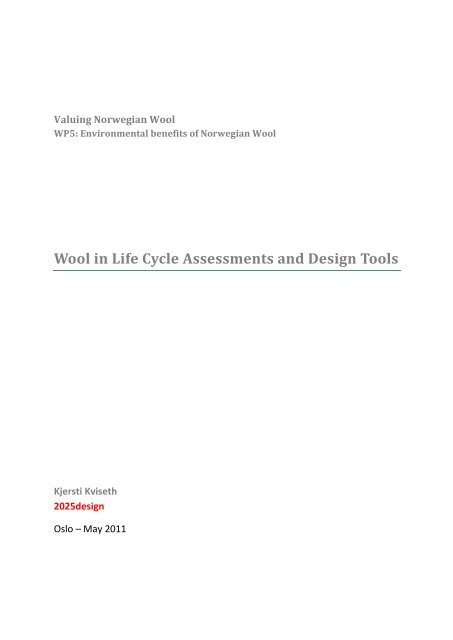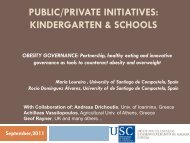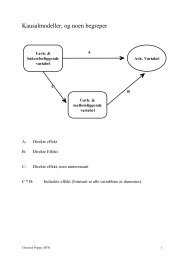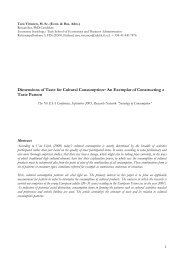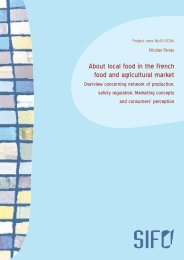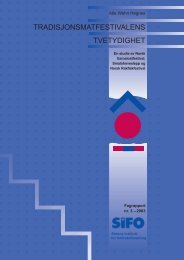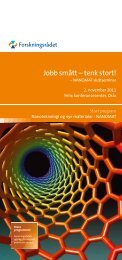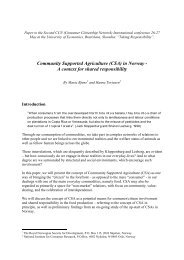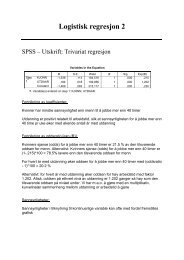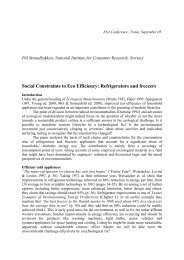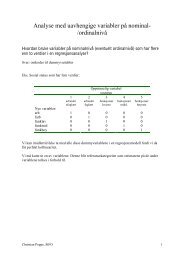Wool in Life Cycle Assessments and Design Tools - SIFO
Wool in Life Cycle Assessments and Design Tools - SIFO
Wool in Life Cycle Assessments and Design Tools - SIFO
- No tags were found...
Create successful ePaper yourself
Turn your PDF publications into a flip-book with our unique Google optimized e-Paper software.
Valu<strong>in</strong>g Norwegian <strong>Wool</strong>WP5: Environmental benefits of Norwegian <strong>Wool</strong><strong>Wool</strong> <strong>in</strong> <strong>Life</strong> <strong>Cycle</strong> <strong>Assessments</strong> <strong>and</strong> <strong>Design</strong> <strong>Tools</strong>Kjersti Kviseth2025designOslo – May 2011
Content1. Introduction2. Abstract KEA Copenhagen3. Summary4. <strong>Life</strong> <strong>Cycle</strong> AssessmentLCA based fiber assessments5. MadeBy6. DEFRA Study7. Assess<strong>in</strong>g natural fibers <strong>in</strong> LCA – example wool8. Challenges <strong>in</strong> compar<strong>in</strong>g fibers <strong>and</strong> textiles9. LCA Methodological Problems <strong>in</strong> the textile Sector10. Reflections on LCA as method - general11. Conclusions on LCA as tool for evaluat<strong>in</strong>g fibers12. Weight<strong>in</strong>g <strong>in</strong> tools<strong>Design</strong> <strong>Tools</strong>13. MadeBy benchmark assessment14. DEFRA Study15. Ecometrics16. NIKE <strong>Design</strong> Tool17. EcoIndex18. Cradle to Cradle - <strong>Life</strong> <strong>Cycle</strong> development19. Stumbl<strong>in</strong>g blocks2
1. IntroductionSeveral tools have emerged dur<strong>in</strong>g the last year <strong>in</strong> order to assist decision mak<strong>in</strong>gs <strong>in</strong> textile design,purchas<strong>in</strong>g <strong>and</strong> manufactur<strong>in</strong>g. They are all based upon <strong>Life</strong> <strong>Cycle</strong> th<strong>in</strong>k<strong>in</strong>g, still quite different <strong>in</strong>content <strong>and</strong> approach. There is need for clarification of differences <strong>and</strong> possibilities.This desl top study takes a closer look at The MadeBy Fiber Benchmark , the DEFRA Study,Ecometrics, the NIKE <strong>Design</strong> tool, EcoIndex <strong>and</strong> Cradle to Cradle <strong>Life</strong> <strong>Cycle</strong> Development. Anyfeedback <strong>and</strong> <strong>in</strong>put from readers is welcome as to adjust <strong>and</strong> improve the <strong>in</strong>formation.MadeBy’s 1 benchmark assessment tool is a <strong>Life</strong> <strong>Cycle</strong> Analysis assess<strong>in</strong>g different fibers up tosp<strong>in</strong>n<strong>in</strong>g. The DEFRA 2 Study goes one step further up to fabric production. In this paper we havema<strong>in</strong>ly looked at the DEFRA Study’s fiber-comparison, pitt<strong>in</strong>g it aga<strong>in</strong>st MadeBy. These two are<strong>in</strong>ventory <strong>and</strong> impact assessments only, provid<strong>in</strong>g facts <strong>and</strong> figures.The Outdoor Industry Association’s 3 Eco-Index <strong>and</strong> NIKE’s <strong>Design</strong> tool are both design tools. EcoIndexis an <strong>in</strong>dicator guide based on life cycle th<strong>in</strong>k<strong>in</strong>g, while NIKE’s is LCA data based. Colour Connection’s 4Eco-metrics is an impact assessment <strong>and</strong> decision-mak<strong>in</strong>g calculator tool based on life cycle data.Cradle to Cradle <strong>Life</strong> <strong>Cycle</strong> Development is a development <strong>and</strong> design method based upon life cycle<strong>in</strong>ventory <strong>and</strong> focus<strong>in</strong>g on improvement <strong>in</strong> the life cycle through design.These have the aim to assist designers, manufacturers <strong>and</strong> consumers <strong>in</strong> their decision-mak<strong>in</strong>g. Theyare <strong>in</strong>ventory-, impact- <strong>and</strong> improvement-tools.Different assessments <strong>and</strong> tools cover different parts of a textile product <strong>Life</strong> <strong>Cycle</strong>. (Ill.by 2025design)1 MadeBy is a Dutch organization which among other th<strong>in</strong>gs has developed a track <strong>and</strong> trace system forcloth<strong>in</strong>g.2 The British Department of Environment, Food <strong>and</strong> Rural Affairs has an ongo<strong>in</strong>g Cloth<strong>in</strong>g Roadmap where thisstudy is a part of the work be<strong>in</strong>g done.3 Formed by the European <strong>and</strong> American Outdoor Associations.4 A British Consultancy work<strong>in</strong>g with major br<strong>and</strong>s on improv<strong>in</strong>g their eco-impr<strong>in</strong>t, specializ<strong>in</strong>g on production <strong>in</strong>the Far East.3
2. Abstract KEA ConferenceSusta<strong>in</strong>ability <strong>in</strong> textiles <strong>and</strong> fashionApril 2011Kjersti Kviseth <strong>and</strong> Tone TobiassonEco-credentials are becom<strong>in</strong>g an important factor <strong>in</strong> the quest for customers <strong>and</strong> profit: Thusdifferent assessments of the environmental impact of a fiber not only show off the eco-footpr<strong>in</strong>t,energy- or water-use; but also becomes a position<strong>in</strong>g-tool <strong>in</strong> the market-place.When Dutch “Made-By” launched their benchmark assessment of fibers, it created quite a stir as itwas one of the first attempts to do an <strong>in</strong>ternational over-all quantified eco-rank<strong>in</strong>g to be used bydesigners, manufacturers <strong>and</strong> consumers. H&M, among others, quickly adopted it as a guide <strong>in</strong>sourc<strong>in</strong>g, but critical voices emerged - especially when it was unearthed that the assessment waslimited up until sp<strong>in</strong>n<strong>in</strong>g. This fact was not clearly communicated <strong>and</strong> created a picture where woolwas ranked <strong>in</strong> the dunce class alongside conventional cotton.This is one recent example of how good <strong>in</strong>tentions can cause confusion when not communicatedclearly, <strong>and</strong> illustrates the complexity of <strong>Life</strong> <strong>Cycle</strong> <strong>Assessments</strong>.The European <strong>and</strong> American Outdoor Group`s Eco-Index <strong>and</strong> Colour Connection`s Eco-metrics offerqualitative eco-<strong>in</strong>dicator guides based on life cycle data, with the aim to assist designers,manufacturers <strong>and</strong> consumers <strong>in</strong> their decision mak<strong>in</strong>gs.This paper addresses the grow<strong>in</strong>g competition for be<strong>in</strong>g the most “eco-friendly” fiber. It discusseswhether LCA is an adequate tool for compar<strong>in</strong>g fibers <strong>and</strong> textiles, <strong>and</strong> compares traditional <strong>Life</strong><strong>Cycle</strong> Analyses with the Cradle-to-Cradle <strong>Life</strong> <strong>Cycle</strong> Development. Further it looks at different <strong>Life</strong><strong>Cycle</strong> Analysis <strong>and</strong> tools that have attempted to rank <strong>and</strong> judge fibers <strong>and</strong> textiles, <strong>and</strong> addresses thechallenges <strong>in</strong> communicat<strong>in</strong>g complex facts to the market.4
3. Summary<strong>Life</strong> <strong>Cycle</strong> Analysis (LCA) has been an available tool <strong>in</strong> <strong>in</strong>dustry for 20 years, but has not developed<strong>in</strong>to a widely used tool for decision mak<strong>in</strong>g <strong>in</strong> companies. It is dependent on specific scientificcompetence <strong>and</strong> data tools <strong>and</strong> is not a convenient tool for designers <strong>and</strong> small companies. MostLCAs are be<strong>in</strong>g used to compare the negative environmental impact of products or services, not asbasis for improvements <strong>and</strong> new designs. There are big differences <strong>in</strong> <strong>in</strong>dividual companyperformance throughout the <strong>in</strong>dustry that is not visible <strong>in</strong> LCA s<strong>in</strong>ce they are ma<strong>in</strong>ly performed withglobal data <strong>and</strong> <strong>in</strong>dustry averages. The scientific world of LCA <strong>in</strong>cludes disagreements on metrics <strong>and</strong>weight<strong>in</strong>gs, <strong>and</strong> is often confus<strong>in</strong>g people by nontransparent or not complete assessments.A textile fiber as raw material represents the first stage of a product`s life cycle <strong>and</strong> must be furtherprocessed to become a product. If conduct<strong>in</strong>g an LCA only of the fiber, most of the <strong>in</strong>tended productlife <strong>and</strong> impact is lack<strong>in</strong>g <strong>and</strong> the LCA becomes a narrow, fragmented study. The s<strong>in</strong>gle stage analysiscreates the risk of misguid<strong>in</strong>g users as be<strong>in</strong>g a complete answer, if not communicated very clearly.The cloth<strong>in</strong>g <strong>in</strong>dustry encompasses both fast-consumption fashion <strong>and</strong> long-term classics. Theecological impacts are dependent just as much on life-time, use <strong>and</strong> end-of-life solutions as they areon material choice <strong>and</strong> manufactur<strong>in</strong>g. Therefore clothes must be designed <strong>in</strong> a complete life cycleperspective, <strong>and</strong> choos<strong>in</strong>g materials must be related to function, esthetics, expected life time, care<strong>and</strong> end-of-life.<strong>Design</strong>ers have the power <strong>and</strong> opportunities to change a negative ecological footpr<strong>in</strong>t <strong>in</strong> to creat<strong>in</strong>gvalue for both people <strong>and</strong> planet. Harmful chemicals can be avoided <strong>in</strong> the products from thebeg<strong>in</strong>n<strong>in</strong>g, <strong>and</strong> plans for the material`s afterlife <strong>and</strong> recycl<strong>in</strong>g can be <strong>in</strong>cluded <strong>in</strong> the design process.This, <strong>in</strong> comb<strong>in</strong>ation with a change <strong>in</strong> consumer behavior, made possible by focus<strong>in</strong>g on quality <strong>and</strong>prevent<strong>in</strong>g bus<strong>in</strong>esses push<strong>in</strong>g McFashion-like consumption.Future focus must be on improvement, <strong>in</strong>novation <strong>and</strong> design <strong>in</strong> a never-end<strong>in</strong>g dynamic process,one example be<strong>in</strong>g the Cradle to Cradle <strong>Design</strong> th<strong>in</strong>k<strong>in</strong>g. If we do th<strong>in</strong>gs right from the beg<strong>in</strong>n<strong>in</strong>g wewill need LCA only as <strong>in</strong>ventory tool, s<strong>in</strong>ce impact is designed to be positive. The Cradle to Cradleapproach has a holistic approach with solutions for all stages at the same time, acknowledg<strong>in</strong>g thateveryth<strong>in</strong>g is connected <strong>and</strong> that if we use nature`s pr<strong>in</strong>ciples <strong>and</strong> do th<strong>in</strong>gs right from the beg<strong>in</strong>n<strong>in</strong>g,we do not end up <strong>in</strong> difficult moral choices between bad or less bad.The textile Industry has started to both develop <strong>and</strong> share design tools that are holistic, easy-to-use<strong>and</strong> communicative. This is very welcome <strong>in</strong> a complex global <strong>in</strong>dustry with huge negativeenvironmental impacts. These tools will contribute to cont<strong>in</strong>uous improvements <strong>in</strong> ecologicalperformances from cloth<strong>in</strong>g throughout their entire life cycles <strong>and</strong> serve the market with transparent<strong>in</strong>formation.Near future will provide us with more useful <strong>and</strong> easy- to- use <strong>Life</strong> <strong>Cycle</strong> based <strong>Design</strong> tools to assist<strong>in</strong>dustry <strong>and</strong> bus<strong>in</strong>ess <strong>in</strong> design, manufactur<strong>in</strong>g <strong>and</strong> purchas<strong>in</strong>g of products. As <strong>in</strong>dustry cont<strong>in</strong>ues tobuild coalitions to cooperate, this will become a strong tool for ecological improvement <strong>and</strong>susta<strong>in</strong>able growth on a larger scale.5
A lot of textiles are manufactured <strong>in</strong> Asia, still there is hardly any site specific data available fromAsian <strong>in</strong>dustry <strong>and</strong> manufactur<strong>in</strong>g. Which leaves us to assumptions <strong>and</strong> approximate data, for<strong>in</strong>stance we can use “worst-case” European data to simulate Ch<strong>in</strong>ese data. Consider<strong>in</strong>g what weknow about work<strong>in</strong>g-conditions <strong>in</strong> Asia, <strong>and</strong> lack of pollution-control of water, l<strong>and</strong> <strong>and</strong> air, this isprobably the biggest void <strong>in</strong> knowledge of real impacts we have. This has not been addressed <strong>in</strong> anystudy so far. S<strong>in</strong>ce large amounts of textiles are manufactured <strong>in</strong> Asian low-cost countries it is a weakpo<strong>in</strong>t <strong>in</strong> all LCA that we lack a lot of real facts <strong>and</strong> life cycle data on impacts from this <strong>in</strong>dustry.LCA is a snapshot of a given situation, stat<strong>in</strong>g facts. It is up to the user to underst<strong>and</strong> how to utilizethis <strong>in</strong>formation as a basis for improvements - <strong>and</strong> if to, alongside mak<strong>in</strong>g good decisions based uponscientific evidence. An LCA is dependent on its <strong>in</strong>put, whoever <strong>in</strong>terprets it, <strong>and</strong> the communicationof f<strong>in</strong>d<strong>in</strong>gs.7
LCA based fiber assessments5. MadeBy Benchmark tool 6The MadeBy Benchmark tool is an example of how if the parameters of a given LCA are notunderstood, used <strong>and</strong> communicated correctly, a certa<strong>in</strong> amount of chaos will ensue. Thisassessment compares the most common fibers from raw material production up to the sp<strong>in</strong>n<strong>in</strong>g ofyarn. This means compar<strong>in</strong>g the non-renewable fossil resource use for mak<strong>in</strong>g polyester with thegrow<strong>in</strong>g of cotton <strong>and</strong> sheep farm<strong>in</strong>g for wool. It does not address the textile production processes;chemicals, waste, pollution, wash <strong>and</strong> disposal of garments. Only few users <strong>in</strong> the textile design <strong>and</strong><strong>in</strong>dustry have the knowledge of LCA methodology, <strong>and</strong> they will easily be misguided as long as theaccompany<strong>in</strong>g <strong>in</strong>struction-document is not spread or read.The first impression is that wool <strong>and</strong> conventional cotton are “bad” fibers <strong>and</strong> recycled polyester <strong>and</strong>organic cotton “good” fibers. Of course recycled fibers are the “best” fibers because energy use isreduced substantially when recycled compared to production of virg<strong>in</strong> fiber. This sounds like an easyrule to follow but there are other consequences that do not compute easily when the assessment isbased on the “truth” that all fibers after sp<strong>in</strong>n<strong>in</strong>g are more or less the same, thus not address<strong>in</strong>g theholistic view of a complete life cycle <strong>and</strong> not consider<strong>in</strong>g different functions, use, life time <strong>and</strong>consumer-behavior.Then the question arises: Why does an organization like MadeBy make a choice with such direconsequences for some fibers? Is it lack of <strong>in</strong>put? Is it lack of underst<strong>and</strong><strong>in</strong>g of the complexity <strong>in</strong> the6 www.made-by.org8
entire LCA? Is it a question of over-simplify<strong>in</strong>g <strong>in</strong> order to please the consumer? Or is this a case ofwolf <strong>in</strong> sheep’s cloth<strong>in</strong>g, try<strong>in</strong>g to manipulate the results to someone’s advantage?“When possible, world average data have been used. However the rank<strong>in</strong>gs should be ratedapproximate, some data are regional specific <strong>and</strong> would not necessarily be applicable if sourcedfrom another region or supply cha<strong>in</strong> us<strong>in</strong>g different techniques (e.g. ra<strong>in</strong> fed l<strong>and</strong> versus irrigatedl<strong>and</strong>)Energy usage <strong>and</strong> GHG emissions could vary widely dependent on each farm <strong>and</strong> energy typeused”. (MadeBy <strong>in</strong> EcoTextile News 2010)6. DEFRA StudyDEFRA Study : The role <strong>and</strong> bus<strong>in</strong>ess case for exist<strong>in</strong>g <strong>and</strong> emerg<strong>in</strong>g fibres <strong>in</strong> susta<strong>in</strong>able cloth<strong>in</strong>g, 2009The fiber comparison <strong>in</strong> the DEFRA Study shows more or less the same as the MadeBy assessment.This study is based upon broad literature studies of LCA of fibers <strong>and</strong> textilesLiterature <strong>and</strong> other sources of <strong>in</strong>formation were collated to identify the environmental impacts ofeach fiber supply cha<strong>in</strong>, from raw material production to factory gate for the above fibers. Data onenergy use (<strong>in</strong>direct <strong>and</strong> direct) <strong>and</strong> water use for each phase of the cha<strong>in</strong> was collated whereavailable. Information on other impacts (greenhouse gas emissions, waste water emissions) wasmuch more limited. Other impacts, such as l<strong>and</strong> use dem<strong>and</strong>s for non-synthetic fibers, werecalculated from the available data.Any LCA on fiber up to sp<strong>in</strong>n<strong>in</strong>g will reach the same conclusion <strong>and</strong> po<strong>in</strong>t to the same “bad guys”;Cotton will always be the water-consumer, wool the l<strong>and</strong>-consumer <strong>and</strong> polyester the nonrenewablesconsumer.Compar<strong>in</strong>g productsLCA is often used to compare products with each other. Therefore it is necessary to consider thewhole life cycle, from cradle to grave, or cradle, <strong>in</strong> order to get a real picture of impacts <strong>and</strong> the realcomparisons of products <strong>and</strong> services. An analysis that looks only at one or a few stages can be doneas well, but must be clearly communicated <strong>and</strong> treated as such.The European Environmental Agency 7 recommends that LCAs are not used to claim a product orservice is environmentally friendly or superior to another. It is possible to claim that us<strong>in</strong>g a specifiedset of criteria, one product is better than another <strong>in</strong> certa<strong>in</strong> aspects of its performance. However ifmak<strong>in</strong>g such claims it is very important that accurate data <strong>and</strong> unbiased <strong>in</strong>formation is used, theassessment has been peer reviewed, <strong>and</strong> not to over-claim.7 European Environmental Agency, EEA, 19979
asis. The f<strong>in</strong>ancial approach is susceptible to marked variations <strong>in</strong> price between locations <strong>and</strong>times.In Norway the wool is estimated to be ca 20% (Animalia 2010) of the sheep economic value, whichwould probably make an allocation of 80/20 between meat <strong>and</strong> wool if an LCA was conducted oncarcass weight.A lot also depends on the agricultural system, the <strong>in</strong>dividual farm, how water, energy <strong>and</strong> l<strong>and</strong> aremanaged. This of course varies <strong>in</strong> different countries, regions <strong>and</strong> even on a local scale one may f<strong>in</strong>dsignificant differences <strong>in</strong> farm management <strong>and</strong> techniques used. Hence the results are more exactthe more site-specific the data is. There is no common global consensus with<strong>in</strong> research on how todeal with different agricultural aspects <strong>in</strong> LCA like allocation rules, greenhouse gas emissions, energyuse etc. Still it is reason to believe that the exist<strong>in</strong>g studies are too old to be representative, <strong>and</strong> theResearchers agree more now than 10 years ago on how to account <strong>and</strong> allocate natural resources <strong>in</strong>LCA. At least they agree that they disagree.Site dependencySite dependency aspects can have more <strong>in</strong>fluence on LCA results than activity dependent aspects.(Cowell <strong>and</strong> Clift (1997)There is some disagreement <strong>in</strong> the scientific community on the impact of site dependency <strong>and</strong> howto calculate this.LCA methodology was orig<strong>in</strong>ally developed for <strong>in</strong>dustrial sites with activities with<strong>in</strong> a build<strong>in</strong>g <strong>and</strong>therefore it is often site-<strong>in</strong>dependent. An <strong>in</strong>dustrial system can be located <strong>in</strong> any location <strong>and</strong>country. In contrast, an agricultural operation is located on a particular parcel of l<strong>and</strong> <strong>and</strong> as a resultis heavily <strong>in</strong>fluenced by the specific l<strong>and</strong> attributes, related climatic <strong>and</strong> environmental factors.Therefore an LCA of polyester manufactured <strong>in</strong> the USA could be compared to Asian manufacturedpolyester utiliz<strong>in</strong>g the same environmental impacts with confidence. (Barber <strong>and</strong> Pellow, 2006)Agricultural operations vary significantly between different locations <strong>and</strong> hence the results of thedifferent life cycle <strong>in</strong>ventory analyses will most likely be significantly different (Milà i Canals, 2003).Prosess emissions are determ<strong>in</strong><strong>in</strong>g environmental performance, This is different from farm to farm,<strong>and</strong> from different countries. Local differncies are important when it comes to GHG, fertilizers, soildepletion etc.LCA was made for <strong>in</strong>dustrial systems, not for natural systems. Nature cannot easily be put <strong>in</strong>tometrics <strong>in</strong> the same way as activity <strong>in</strong> an <strong>in</strong>dustrial site can be measured, where <strong>in</strong>puts <strong>and</strong> outputsare more easily monitored. If the world was accord<strong>in</strong>g to LCA, cows <strong>and</strong> sheep would be banned, <strong>and</strong>battery hens would be the best option, all because the metrics say so.“As with all agricultural products the numbers vary greatly based on the system. A wool frommore arid regions of Australia will be significantly different than a wool from Engl<strong>and</strong>.”Eric Williams, Brown <strong>and</strong> Williams 8Global wool?So far no LCA on global wool has been publically available. Choos<strong>in</strong>g a global wool study of one kilo<strong>in</strong>stead of local studies like the one conduced <strong>in</strong> New Zeal<strong>and</strong> 9 , is comparable to the difference8 Quote from an e-mail dialogue with Eric Williams, Brown <strong>and</strong> Williams, USA, 2011, LCA consultants forMadeBy <strong>and</strong> NIKE9 Barber <strong>and</strong> Pellow, 200612
etween a full color palette <strong>and</strong> mix<strong>in</strong>g all colors <strong>in</strong> the palette so everyth<strong>in</strong>g becomes brownishgrey.<strong>Wool</strong> from sheep is best evaluated as a regional or local raw material with different profiles; this issupported by all LCA literature found on wool <strong>and</strong> textiles. Diversity should be appreciated <strong>and</strong> thestrengths of each region <strong>and</strong> each fiber should be highlighted, rather than watered out by worldaverages.The advantage of positive local or other qualities <strong>and</strong> impacts, the fact of “do<strong>in</strong>g good”should also be communicated.To get wool out of the “dunce” position one must compare the complete life cycles of fibers,<strong>in</strong>clud<strong>in</strong>g the areas of positive impacts. This <strong>in</strong>cludes, <strong>in</strong> the case of wool, use <strong>and</strong> reuse, air<strong>in</strong>g vsfrequent wash<strong>in</strong>g, natural fire-retard<strong>in</strong>g, moisture-absorbance, <strong>and</strong> the ability to keep us warm whenit is cold <strong>and</strong> cool when it is hot. This is not part of a classic LCA, but possible if conduct<strong>in</strong>g a Cradle toCradle evaluation <strong>and</strong> <strong>Life</strong> <strong>Cycle</strong> Development.<strong>Wool</strong> could, <strong>in</strong> theory, be made with virtually hardly any negative impacts. It grows on ra<strong>in</strong> water <strong>and</strong>grass, <strong>and</strong> is a by-product of meat-, milk- <strong>and</strong> lanol<strong>in</strong>-production. <strong>Wool</strong> aids l<strong>and</strong>scap<strong>in</strong>g. By replac<strong>in</strong>gpesticides <strong>and</strong> process-chemicals with those proven to be compatible with nature, animal <strong>and</strong> humanhealth, by ensur<strong>in</strong>g clean waste-water <strong>and</strong> us<strong>in</strong>g renewable energy both for farm<strong>in</strong>g <strong>and</strong> process<strong>in</strong>g –wool is suddenly no longer a “dunce”. <strong>Design</strong><strong>in</strong>g for a long life-span, reuse <strong>and</strong> recycl<strong>in</strong>g furtherenhances wool’s eco-profile, by creat<strong>in</strong>g qualities that will be loved <strong>and</strong> cared for, even throughgenerations.“When us<strong>in</strong>g LCA results for wool you need a study for the specific farm or region, or from severalcountries/regions that correctly represent global wool production” (J. Pettersen, MISA 10 )8. Challenges <strong>in</strong> compar<strong>in</strong>g different fibers <strong>and</strong> textilesTo compare natural fibers with synthetic fibers is more complex than it seems. It is nature versus<strong>in</strong>dustry, renewables versus non-renewables.Any comparison of fibers is only fair if we consider the whole life cycle of a given garment, <strong>and</strong><strong>in</strong>clude all life cycles of the material throughout use, reuse <strong>and</strong> the potential for recycl<strong>in</strong>g. Fibers <strong>and</strong>textiles have different qualities, strengths <strong>and</strong> weaknesses. When compar<strong>in</strong>g different fibers it isnecessary to consider that they are different products with different production-processes, uses <strong>and</strong>ma<strong>in</strong>tenance.One product might have huge emissions <strong>in</strong> the raw-material phase, others <strong>in</strong> the user-phase.Polyester has high CO 2 emissions <strong>in</strong> the raw-material phase, but uses less dyestuff than other fibers<strong>and</strong> is excellent for material recycl<strong>in</strong>g. <strong>Wool</strong> grows on grass <strong>and</strong> ra<strong>in</strong>water, but has large effluentwaterimpact when scoured, but requires less wash<strong>in</strong>g <strong>in</strong> the user-phase. One impact can bebalanced by another.When compar<strong>in</strong>g different fibers it is necessary to consider that they are different products withdifferent production processes, uses <strong>and</strong> ma<strong>in</strong>tenance. Therefore the whole life cycle must be<strong>in</strong>cluded, because all life stages count <strong>and</strong> <strong>in</strong>fluence the results. One product might have hugeemissions <strong>in</strong> the raw material phase, others <strong>in</strong> the user phase.A few general remarks on LCA for textiles from the DEFRA Study In a wider perspective, studies should take account of the durability <strong>and</strong> lifetime of apparelproducts (<strong>in</strong>clud<strong>in</strong>g end of life use or re-use)….10 MISA, Environmental Systems Analyses, Trondheim Norway, 201113
LCA studies should for example ensure allocation of appropriate environmental burdenshar<strong>in</strong>g to co-products of natural fiber production to enable more appropriate comparisons…There is a further need to agree on approaches to balance or weight different environmentalimpacts <strong>in</strong> a mean<strong>in</strong>gful way for the textile <strong>in</strong>dustry so more simplified eco-rat<strong>in</strong>gs can bedeveloped for textiles <strong>and</strong> textile fibers.9. LCA Methodological Problems <strong>in</strong> the textile Sector“<strong>Life</strong> <strong>Cycle</strong> Assessment (LCA) applied <strong>in</strong> the Textile Sector: the Usefulness, Limitations <strong>and</strong>Methodological Problems – A Literature Review.” 11 Lisbeth Dahllöf 2004System BoundariesSimplified LCAs do fit <strong>in</strong>to the ISO st<strong>and</strong>ards, but it could be tempt<strong>in</strong>g to exclude side processes orproducts such as help chemicals without really know<strong>in</strong>g the extent of environmental burden theycause, with mislead<strong>in</strong>g results. Simplified LCAs require experienced practitioners conduct<strong>in</strong>g thestudies, <strong>and</strong> dom<strong>in</strong>ance <strong>and</strong> sensitivity analyses are important to ma<strong>in</strong>ta<strong>in</strong> reliability.Functional UnitAccord<strong>in</strong>g to ISO 14041 “one of the primary purposes of a functional unit is to provide a reference towhich the <strong>in</strong>put <strong>and</strong> output data are normalized (<strong>in</strong> a mathematical sense). Therefore the functionalunit shall be clearly def<strong>in</strong>ed <strong>and</strong> measurable”. In the <strong>in</strong>dustrialized world, clothes are not used rightup to the po<strong>in</strong>t that they are worn out. If you want to compare a cotton shirt with a shirt made ofpolyester, not only the quality but also the feel<strong>in</strong>g could be an important factor <strong>in</strong> how long the shirtwill be used. This type of “soft” considerations is better done outside the LCA study. In some cases, amore general functional unit could be used such as “wear<strong>in</strong>g clean clothes per person dur<strong>in</strong>g a year”which is done <strong>in</strong> the SusHouse project (Bras-Klapwijk, 2001).Several environmental impacts are usually not considered <strong>in</strong> LCA studies of textiles, so it is unknownhow serious they are compared to other impacts. Many of them are serious on a local scale butpossibly are unimportant globally. Noise <strong>and</strong> dust <strong>in</strong> the work<strong>in</strong>g environment are such impacts. This<strong>in</strong> comb<strong>in</strong>ation with the different orig<strong>in</strong>s makes it difficult to compare e.g. polyester <strong>and</strong> cottonfabrics objectively regard<strong>in</strong>g environmental impact. Some researchers explicitly state that productscannot be compared <strong>in</strong> an adequate way (e.g. Werner, 2002). Still, studies made to compare thesetextile types show the need for weight<strong>in</strong>g suited to the textile sector (Kalliala, 1997, Svensson E.,1995, Svensson E., 1997).When read<strong>in</strong>g an LCA report, it is important to know that LCA studies usually describe global orregional effects <strong>and</strong> not local ones, although they may assess these. Solvent emission from a plantmay be <strong>in</strong>significant on a global scale but still cause problems to man <strong>and</strong> nature <strong>in</strong> the immediatesurround<strong>in</strong>gs. Research is be<strong>in</strong>g done on describ<strong>in</strong>g the local effects <strong>and</strong> fitt<strong>in</strong>g them <strong>in</strong>to the LCAframework (Baumann <strong>and</strong> Tillman 2004).AllocationsAllocation choice is particularly important for sheep farm<strong>in</strong>g <strong>and</strong> wool production; For almost allcountries produc<strong>in</strong>g wool, it is a secondary product of meat production, but <strong>in</strong> Australia, the largest11 an excerpt of f<strong>in</strong>d<strong>in</strong>gs from Dahllöfs studies <strong>and</strong> thesis, on ma<strong>in</strong> challenges that apply for textiles<strong>in</strong> general <strong>and</strong> wool <strong>in</strong> particular. (kk2011)14
wool produc<strong>in</strong>g country <strong>in</strong> the world, wool is the primary product (Ellebäk Laursen, et al, 1997). It istherefore not evident how to allocate, <strong>and</strong> it is necessary to allocate differently for different cases.One should be careful when draw<strong>in</strong>g general conclusions from an LCA study. The results cannot, for<strong>in</strong>stance, be used without modifications, if fabrics for clothes are to be assessed. The use phasewould then be of greater importance, because of more frequent clean<strong>in</strong>g of the fabric. (Dahllöf)10. Reflections on LCA <strong>in</strong> generalTo conduct LCA reports is a time- <strong>and</strong> money consum<strong>in</strong>g activity that is mostly done by midsized <strong>and</strong>large companies. x% of Norwegian companies do not see any value added. Reports easily end up <strong>in</strong> adesk drawer. Money <strong>and</strong> time spent is useless if the result is not used as a basis for strategic choicesof environmental improvements at various po<strong>in</strong>ts <strong>in</strong> a life cycle of a product, or for f<strong>in</strong>d<strong>in</strong>g relevantenvironmental <strong>in</strong>dicators that can be used for future developments <strong>and</strong> compar<strong>in</strong>g.A lot of the criticism aga<strong>in</strong>st LCA comes from the LCA scientific community. Issues that are discussedare; wrong results as result of wrong def<strong>in</strong>ed system boundaries, (Callaghan og Allen: 1994),complicated data collection (Ayres: 1995), uncerta<strong>in</strong>ties on choice of method (Fava: 1997) <strong>and</strong>challeng<strong>in</strong>g <strong>in</strong>terpretations. (F<strong>in</strong>nveden: 2000)It is important to realize that LCA is one tool among other tools to evaluate environmental impacts.Other tools <strong>in</strong>clude Environmental Impact Assessment (EIA) <strong>and</strong> Susta<strong>in</strong>able Development Records(SDR) (Tillman et al, 1997)Generally LCA is focused upon what harm a product makes, count<strong>in</strong>g the negative impacts on theenvironment. Some positive impacts like recycled content or use of renewable energy are more <strong>and</strong>more be<strong>in</strong>g considered. Still it is not a tool for report<strong>in</strong>g good news, just the bad <strong>and</strong> the less bad.In the jungle of dataLCAs have different figures on the same impacts, depend<strong>in</strong>g on the many variables that def<strong>in</strong>e theanalyzed system. If the framework is not communicated well or not understood it is a source tomisunderst<strong>and</strong><strong>in</strong>gs <strong>and</strong> mis<strong>in</strong>terpret<strong>in</strong>g. Different databases use data from different global regions.Data change with time <strong>and</strong> technology, <strong>and</strong> many LCA are already old <strong>and</strong> outdated <strong>in</strong> their datafacts. This might get very confus<strong>in</strong>g <strong>and</strong> mislead<strong>in</strong>g to the user.One example; In a LCA on New Zeal<strong>and</strong> Mer<strong>in</strong>o (Barber <strong>and</strong> Pellow 2004) they refer to Frankl<strong>in</strong>Associates (1993) stat<strong>in</strong>g the average carbon dioxide emission factor for polyester to be 6,9 kgCO2/kg PET. Look<strong>in</strong>g <strong>in</strong>to Frankl<strong>in</strong> Associates (USA) studies on PET for dr<strong>in</strong>k<strong>in</strong>g bottles (2007) itstates 3,28 kg CO2/kg PET, which is more correspond<strong>in</strong>g with the European Eco<strong>in</strong>vent Database atthe same time(2008). Both figures are based upon average energy mix from the grid, both US <strong>and</strong>Europe.What happened? Has the production of PET changed? Has the energy <strong>in</strong>put <strong>and</strong> source changed?Was it a US number compared with an European number? Did Barber <strong>and</strong> Pellow (2006) mis<strong>in</strong>terpretthe numbers from Frankl<strong>in</strong> Associates like that the numbers were per kg <strong>and</strong> not per functional unit?Or did I miss someth<strong>in</strong>g when read<strong>in</strong>g? The answer may be found <strong>in</strong> all areas.Another example is the variety range <strong>in</strong> eg energy data. Risks <strong>in</strong> this case are <strong>in</strong>dividual<strong>in</strong>terpretations or be<strong>in</strong>g mistaken by accident, or not hav<strong>in</strong>g the necessary skills to <strong>in</strong>terpret the rightway, or by us<strong>in</strong>g old data. It also shows a possibility for manipulation of results by choos<strong>in</strong>g thepreferred data.15
Textile Fibre Energy Use example (MJ/kg fibre)Cotton 13-60<strong>Wool</strong> 8-38The uncerta<strong>in</strong>ties add to a complex picture once you start to see that the same uncerta<strong>in</strong>ties <strong>and</strong>appear <strong>in</strong> different stages of the life cycle. It requires a good scientist with good <strong>in</strong>tentions to<strong>in</strong>terpret <strong>and</strong> use the available data <strong>in</strong> the best way possible for the user, <strong>and</strong> a user with cleanglasses to underst<strong>and</strong> <strong>and</strong> use it properly.Metrics versus natureThere have been several attempts to sum up environmental impact <strong>in</strong> a small number of <strong>in</strong>dicators,or even just 1 s<strong>in</strong>gle magic number. How convenient wouldn`t that be, to be able on a scale from 1 to10 to def<strong>in</strong>e a products total value <strong>and</strong> impact? Easy to compare <strong>and</strong> easy to communicate.But how much sense does it actually make to put nature <strong>in</strong>to high mathematics formula <strong>and</strong> metrics?Do we really believe that mathematics is the right way out of environmental trouble? Or are theanswers to be found somewhere else, like <strong>in</strong> nature itself? Don`t we already know most of theanswers through common sense <strong>and</strong> basic knowledge of ecosystems?Humans want to control nature, to get the most out of it without giv<strong>in</strong>g much back. And we believewe can put nature <strong>in</strong>to our believe system of be<strong>in</strong>g superior to it. Nature can to a certa<strong>in</strong> extent <strong>in</strong>several areas be def<strong>in</strong>ed by mathematics, but not the different environmental impacts as one figure.You may count the numbers of trees <strong>in</strong> the forest or the volume of water flow<strong>in</strong>g <strong>in</strong> the river, <strong>and</strong>even their economic value. Still the ecological value cannot be determ<strong>in</strong>ed <strong>in</strong> one mathematicalfigure. How much sense does it make to spend so much time <strong>and</strong> money on calculations that do notmake much sense or improve the quality of nature <strong>and</strong> human life? What is the actual value creat<strong>in</strong>gcontribution from this k<strong>in</strong>d of example? Moneywise it is probably a much higher <strong>in</strong>put than output.Follow<strong>in</strong>g this idea, we will cont<strong>in</strong>ue to fight for <strong>and</strong> develop non effective wrong systems, <strong>and</strong> keepwalk<strong>in</strong>g around <strong>in</strong> circles but not really clos<strong>in</strong>g loops.Limitation of LCAAll fibers have other features or positive impacts that are normally not spoken about or highlighted<strong>in</strong> an LCA. This might be related to esthetics, tactility, comfort, temperature, laundry, recycl<strong>in</strong>g, etc.<strong>Wool</strong> has several positive functional qualities, highlighted <strong>in</strong> the illustration. These features areimportant to consider <strong>in</strong> a holistic view <strong>and</strong> life cycle development of wool products.16
11. Conclusions on LCA as tool for evaluat<strong>in</strong>g fibersLCA is complex <strong>and</strong> complicated, <strong>and</strong> that results are depend<strong>in</strong>g on a huge amount of differentfactors <strong>and</strong> uncerta<strong>in</strong>ties. LCA can be manipulated with<strong>in</strong> acceptable methodological limits to give awanted result. You get what you pay for.If the purpose is to compare results with other similar products then the result depends on whetheryou actually are compar<strong>in</strong>g apples with cars or apples with apples, both <strong>in</strong> terms of the sameframework for the analysis <strong>and</strong> how you look at <strong>and</strong> weigh the results.Several impacts are normally not covered by an LCA, like social aspects, work<strong>in</strong>g environment, localpollution, noise etc. Ma<strong>in</strong>ly because it is too cost <strong>and</strong> time <strong>in</strong>tensive to conduct.The MadeBy Benchmark tool is an example of how chaotic this all might get if not understood, used<strong>and</strong> communicated correctly. The benchmark is misguid<strong>in</strong>g the user even if the <strong>in</strong>tention may havebeen good. Is it lack of good advice? Is it lack of underst<strong>and</strong><strong>in</strong>g the complexity? Or is this a case ofwolf <strong>in</strong> sheep clothes, try<strong>in</strong>g to manipulate the communication of the results to their advantage?So far no LCA on global wool has been performed that is publically available. Choos<strong>in</strong>g a one globalwool study is like the difference between a full color palette, <strong>and</strong> mix<strong>in</strong>g all colors <strong>in</strong> the palette soeveryth<strong>in</strong>g gets shitty brownish.The DEFRA Study argues that “it is important that the LCA literature concentrates less on thespecifics of production <strong>in</strong> a specific location <strong>and</strong> by a specific approach, but contributes more widelyto generic assessments of the environmental impacts of different textile fibers while highlight<strong>in</strong>g thesources of variability that help identify where reduced environmental impacts can be achieved”.It does not argue why or address the difficulties <strong>in</strong> assess<strong>in</strong>g agricultural activities.17
To get wool out of the bad-guy position one must compare complete life cycles, <strong>in</strong>clud<strong>in</strong>g thepositive impacts. Includ<strong>in</strong>g all the good stuff related to use <strong>and</strong> reuse, like air clean<strong>in</strong>g, natural fireretard<strong>in</strong>g, moist absorbance, little wash<strong>in</strong>g needed, <strong>and</strong> keep<strong>in</strong>g people warm. This is possible ifconduct<strong>in</strong>g a Cradle to Cradle evaluation <strong>and</strong> <strong>Life</strong> <strong>Cycle</strong> Development.Imag<strong>in</strong>e wool made without negative impacts. Already runn<strong>in</strong>g on ra<strong>in</strong> water <strong>and</strong> partly wild growngrass it has good start<strong>in</strong>g po<strong>in</strong>t. The rest can be done by replac<strong>in</strong>g pesticides <strong>and</strong> process chemicalswith those who are proven to be compatible with nature, animal <strong>and</strong> human health, <strong>in</strong>clud<strong>in</strong>g cleanwaste water <strong>and</strong> us<strong>in</strong>g renewable energy both for farm<strong>in</strong>g <strong>and</strong> process<strong>in</strong>g. <strong>Design</strong><strong>in</strong>g for the optimallife time, reuse <strong>and</strong> recycl<strong>in</strong>g comes next <strong>and</strong> creat<strong>in</strong>g textile qualities that will be loved <strong>and</strong> caredfor.<strong>Design</strong> tools“It’s pretty tedious <strong>and</strong> difficult to conduct a full LCA for even one product. And when you’re done,it says “Oh, here’s the impact of your product used <strong>and</strong> disposed of <strong>in</strong> a certa<strong>in</strong> way.” Trouble is,that doesn’t reduce anyth<strong>in</strong>g; it just tells you how bad it is”.US <strong>Design</strong>er Steve Eppmann 12To perform a detailed life cycle assessment before start<strong>in</strong>g to make improvement <strong>and</strong> redesign is anexpensive <strong>and</strong> slow way to make change. Rather than a complete <strong>and</strong> detailed LCA it may be moreuseful to conduct a qualitative assessment of a given product, s<strong>in</strong>ce the ma<strong>in</strong> impacts are normallyeasy to detect. This would give a better underst<strong>and</strong><strong>in</strong>g of the improvement possibilities.It is widely accepted today that future environmental impacts are <strong>in</strong>vented <strong>in</strong> the <strong>in</strong>novation <strong>and</strong>design phase, <strong>and</strong> that this is where they must be addressed. <strong>Design</strong>ers <strong>and</strong> product developers havehuge responsibility, but also a lot of possibilities to make good products.Hence it is important to <strong>in</strong>clude design <strong>and</strong> <strong>in</strong>novation th<strong>in</strong>k<strong>in</strong>g <strong>in</strong>to LCA processes <strong>and</strong> methodology.LCA should focus more on the improvement phase, <strong>in</strong> order to help speed up the environmentalimprovements we need, not only <strong>in</strong> the textile <strong>in</strong>dustry. <strong>Design</strong> tools like NIKE’s <strong>and</strong> EcoIndex, alongwith Cradle to Cradle <strong>Design</strong>, are promis<strong>in</strong>g approaches that can make positive improvements <strong>and</strong>better environmental choices more easily available for everyone. <strong>Tools</strong> must be easy to use <strong>and</strong> easyto underst<strong>and</strong> for all decision makers, not only for specialists.12. Weight<strong>in</strong>g <strong>in</strong> toolsWeight<strong>in</strong>g of different impact categories <strong>and</strong> <strong>in</strong>dicators is h<strong>and</strong>led different by each actor, mak<strong>in</strong>g itmore complicated to compare results.MadeBy has given Green House Gases (GHG) <strong>and</strong> toxics the highest impact weight<strong>in</strong>g, <strong>and</strong> energy,water <strong>and</strong> l<strong>and</strong> use less. In comparison NIKE has chosen a different impact-key with toxics as the12 MIT Sloan Management Review, Interview October 201018
highest followed by Greenhouse Gases <strong>and</strong> energy use. Ecometrics has a non-transparent weight<strong>in</strong>gkey, translated <strong>in</strong>to Environmental Damage Units (EDU). (see Figure 3)Figure 3; Impact categories, <strong>in</strong>dicators <strong>and</strong> weight<strong>in</strong>g (Ill. 2025design)In the end it is impossible to compare apples with pears, <strong>and</strong> a challenge to judge the different stagesup aga<strong>in</strong>st each other. How to weight the significance <strong>and</strong> impact-importance of CO 2 fromproduction, aga<strong>in</strong>st heavy-metals <strong>in</strong> the dye<strong>in</strong>g process, aga<strong>in</strong>st the energy-consumption of thewash<strong>in</strong>g mach<strong>in</strong>e? All negative impacts are important to assess, <strong>and</strong> yet they are very different.The different assessment <strong>and</strong> design tools available have chosen different weight<strong>in</strong>g models <strong>and</strong>environmental impact categories. This gives different results with the different tools for the samefiber or product. It is difficult for others than the tool-owner to use a company specific rat<strong>in</strong>g that isrelated to <strong>in</strong>ternal policies <strong>and</strong> strategies, s<strong>in</strong>ce this is not transferable as a generic tool suitable forany other company. Without know<strong>in</strong>g or shar<strong>in</strong>g the priorities set <strong>and</strong> the methods used there is afair chance of misunderst<strong>and</strong><strong>in</strong>g, mis<strong>in</strong>terpret<strong>in</strong>g <strong>and</strong> generally mislead<strong>in</strong>g others. And still there isno right or wrong <strong>in</strong> how to conduct this weight<strong>in</strong>g. NIKE`s tool has weight<strong>in</strong>g based on their <strong>in</strong>ternalpolicies <strong>and</strong> strategies, which makes it right for them, but not necessarily right for any othercompany unless they adapt the same policies. Hence equal weight<strong>in</strong>g as NIKE is consider<strong>in</strong>g could bediscussed.19
13. EcoMetricsEcometrics 13 was developed by Phil Patterson at UK`s Colour Connections. The tool was released <strong>in</strong>2009. EcoMetrics is an on-l<strong>in</strong>e calculator that enables one to compare the environmental impacts ofdifferent textile products <strong>and</strong> processes up-stream <strong>and</strong> down-stream.EcoMetrics is the only tool to look at reduced textile consumption <strong>and</strong> product durability.Colour Connections aim to use EcoMetrics to educate <strong>and</strong> po<strong>in</strong>t out some very obvious problems <strong>and</strong>opportunities rather than gett<strong>in</strong>g bogged down <strong>in</strong> an academic debate about mathematics.The motivation beh<strong>in</strong>d it is that too many products are be<strong>in</strong>g sold based on one s<strong>in</strong>gle good attributewhen overall they are not very good. Also a lot of ‘green’ fibres <strong>and</strong> products are just ‘less bad’ thanst<strong>and</strong>ard products whilst not actually be<strong>in</strong>g good. Patterson also wanted to expose disposablefashion as be<strong>in</strong>g very bad for the environment.Plans exist to develop the tool to <strong>in</strong>clude fabric blends <strong>and</strong> to look at real world scenarios, e.g. whereyou can compare a cotton product dyed <strong>in</strong> a good dye-house with one dyed <strong>in</strong> a dye-house with abad eco-profile. They score impacts to give users an <strong>in</strong>dication of whether products <strong>and</strong> process arebetter or worse than other options. They do not have any hidden agenda, so it isn’t biased towardsor aga<strong>in</strong>st any particular fibre.An example; The world’s best cotton dyers will use about 50 litres of water to dye a kg offibre/yarn/fabric <strong>and</strong> there are very few of them. The ‘average dyers’ will use about 100 litres to dyea kg <strong>and</strong> there are a lot of them. And f<strong>in</strong>ally there are some appall<strong>in</strong>g dyers who use 600 or 700hundred litres of water to dye a kg – <strong>and</strong> there are lots of these, but dye<strong>in</strong>g very small volumes ofcotton. The best dyers will know exactly how much water they are us<strong>in</strong>g, the average ones will know+/- 20% what they are us<strong>in</strong>g <strong>and</strong> the awful ones won’t have a clue.Exclud<strong>in</strong>g the awful ones from the arithmetic pa<strong>in</strong>ts a way too good picture of the <strong>in</strong>dustry <strong>and</strong>, s<strong>in</strong>cemany br<strong>and</strong>s have no idea where their products are dyed, gives them a false sense of security <strong>and</strong>underestimates the environmental damage.“If you saw what chemicals used to make dyes (<strong>in</strong> very controlled conditions I stress) <strong>and</strong>made judgments on just the <strong>in</strong>puts rather than the controls you would close the textile<strong>in</strong>dustry down tomorrow”. Phil Patterson, Color Connections 201113 www.colour-connections.com/EcoMetrics20
Fig. Screenshots from EcoMetrics; Calculator <strong>and</strong> Result examples for wool <strong>and</strong> cottonThey developed assigned environmental damage units (EDU’s) to energy impacts, water impacts,chemical impacts <strong>and</strong> pollution impacts. The exact method of convert<strong>in</strong>g energy impacts <strong>and</strong> waterimpacts etc <strong>in</strong>to EDU’s is not publicly available. The data that is fed <strong>in</strong>to the EDU conversion is basedon ‘Industry averages’, us<strong>in</strong>g real data <strong>and</strong> estimates.EcoMetrics would consider a factory with solar panels <strong>and</strong> w<strong>in</strong>d turb<strong>in</strong>es to be low impact even iftheir energy usage was high. Likewise with wool it looks at the impacts – the l<strong>and</strong> use is high butwhat else would the l<strong>and</strong> be used for? If sheep were raised on prime agricultural l<strong>and</strong> the impactwould be much higher, but they are raised on mounta<strong>in</strong>s where noth<strong>in</strong>g else can be grown. (PhilPatterson 14 )14 Quote: Phil Patterson, Colour Connections, 201121
14. Nike Environmental Apparel <strong>Design</strong> ToolThe Nike Environmental Apparel <strong>Design</strong> Tool 15 serves as functional calculator with the ability tomeasure the impact of materials commonly used <strong>in</strong> manufactur<strong>in</strong>g apparel products. The Toolevaluates waste, energy, toxics <strong>and</strong> water <strong>in</strong> materials <strong>and</strong> manufactur<strong>in</strong>g, enabl<strong>in</strong>g NIKE to <strong>in</strong>fluencethe most significant components of a product’s environmental impact.The tool takes a pragmatic, strategic life cycle management approach where susta<strong>in</strong>ability is viewedas a journey rather than a static measurement of impacts. The use of product scores <strong>and</strong> labels suchas Gold, Silver <strong>and</strong> Bronze for scor<strong>in</strong>g <strong>and</strong> communication helps to simplify a complex task, mak<strong>in</strong>gsusta<strong>in</strong>ability concrete enough to br<strong>in</strong>g designers on board, giv<strong>in</strong>g them the <strong>in</strong>formation <strong>and</strong><strong>in</strong>centives to make a real impact through design choices.“Nike is releas<strong>in</strong>g its Environmental Apparel <strong>Design</strong> Tool with support<strong>in</strong>g data <strong>and</strong>methodology for public review. We hope by shar<strong>in</strong>g this knowledge it will acceleratecollaboration <strong>and</strong> encourage broader adoption of susta<strong>in</strong>ability pr<strong>in</strong>ciples…. It is abeg<strong>in</strong>n<strong>in</strong>g; a build<strong>in</strong>g block from which someth<strong>in</strong>g better can be created.” 16Scientifically based <strong>and</strong> designed to be simple-to-use.Numbers-based, so a direct product, material, or process comparison becomes practical,underst<strong>and</strong>able, <strong>and</strong> realistic to benchmark aga<strong>in</strong>st.Easy-to-use <strong>and</strong> fits easily with<strong>in</strong> the already dem<strong>and</strong><strong>in</strong>g workload of our <strong>in</strong>tended audiences:product creation teams, product designers, product managers, material suppliers <strong>and</strong> productmanufacturers, students <strong>and</strong> universities, <strong>in</strong>dustry groups, <strong>and</strong> <strong>in</strong>terested NGOs.Its aim at the ability to make more <strong>in</strong>formed design choices, <strong>in</strong>creas<strong>in</strong>g efficiency <strong>and</strong> reduc<strong>in</strong>g wasteThe tool is based upon a Material Analyses Tool based on lifecycle th<strong>in</strong>k<strong>in</strong>g. Each material is assigneda numeric value that translates <strong>in</strong>to a susta<strong>in</strong>ability score for our products. The MAT framework iscomprised of a set of environmental impact questions, <strong>in</strong> four categories; Energy, Human Toxicology,Waste management <strong>and</strong> water consumption. 17Treatment recipes conta<strong>in</strong><strong>in</strong>g enzymes, chemicals, <strong>and</strong> additives, vary<strong>in</strong>g degrees of water use <strong>and</strong>water temperature, treatment time, <strong>and</strong> mechanical distress<strong>in</strong>g can all be comb<strong>in</strong>ed <strong>in</strong> an <strong>in</strong>f<strong>in</strong>itenumber of ways <strong>and</strong> <strong>in</strong>tensity levels, <strong>and</strong> applied to a f<strong>in</strong>ished garment. No two comb<strong>in</strong>ations are thesame. Exact recipes may be closely guarded trade secrets, <strong>and</strong> are often seen as a wash-house’scompetitive advantage. All of this complexity, though, adds up to a simple reality: garmenttreatments amount to additional energy, water, chemistry, <strong>and</strong> / or potential waste <strong>in</strong> themanufactur<strong>in</strong>g process. Not typically considered <strong>in</strong> most <strong>in</strong>dustry <strong>in</strong>dexes, we believe garmentprocesses should be assessed because they clearly result <strong>in</strong> additional environmental impacts.15 http://www.nikebiz.com/responsibility/nikeenvironmentaldesigntool17 (Brown <strong>and</strong> Willmanns performed the MAT for NIKE, as well as the MAdeBy LCA. red.)22
From this ‘whole systems’ perspective, it needs to be clearly stated that there is no suchth<strong>in</strong>g as a susta<strong>in</strong>able or an unsusta<strong>in</strong>able material or product; there are only susta<strong>in</strong>ablematerial <strong>and</strong> resourcemanagement practices. Product <strong>and</strong> material susta<strong>in</strong>ability claimstherefore need to be viewed carefully, <strong>and</strong> as part of a journey toward susta<strong>in</strong>ability – onethat has many possible pathways.The Natural Step 2010NIKE discusses some important issues <strong>and</strong> challenges related to weight<strong>in</strong>g of impacts:“When we began work on our materials tool, we wrestled with tough environmental questionsregard<strong>in</strong>g environmental tradeoffs. For example, how should we evaluate the impacts of water<strong>in</strong>tensity with CO2 emissions with carc<strong>in</strong>ogenicity? The impact weight<strong>in</strong>g <strong>in</strong> this version of the toolreflects Nike values when we first developed it <strong>in</strong> 2008. At that time, chemistry was given 40% of theoverall weight, energy/CO2 24%, waste 20%, <strong>and</strong> water/l<strong>and</strong> 16%. Over the past year, Nike’sConsidered Team has determ<strong>in</strong>ed that there is no <strong>in</strong>dustry consensus or st<strong>and</strong>ard po<strong>in</strong>t of viewregard<strong>in</strong>g the relative weight<strong>in</strong>g of environmental impact area. For that reason we have drafted anew version of MAT with revised weight<strong>in</strong>g, framework, impact metrics, <strong>and</strong> MAT data methodology.One of the key changes will be <strong>in</strong> MAT v2.0 is equally weight<strong>in</strong>g each impact area – energy/CO2,ater/l<strong>and</strong>, waste, <strong>and</strong> chemistry are all worth 25% of the total possible po<strong>in</strong>ts”.15. EcoIndexThis Eco<strong>in</strong>dex 18 is developed by the Outdoor Industry Assosiation. It is a tool for development <strong>and</strong>evaluation of complete garments <strong>and</strong> products, <strong>in</strong>clud<strong>in</strong>g packag<strong>in</strong>g. It is based upon life cycleth<strong>in</strong>k<strong>in</strong>g for complete products. While the long-term goal is a data-driven life cycle evaluation there islittle to no data yet collected. The current approach uses <strong>in</strong>dicators. It rates one piece of garment<strong>and</strong> packag<strong>in</strong>g, not the fiber as such, <strong>and</strong> makes it easy to compare with other similar products. Thismakes it a very practical tool for designers <strong>and</strong> manufacturers. It has a positive focus of preferable<strong>in</strong>puts.The Eco Index is designed to help determ<strong>in</strong>e how the <strong>in</strong>dustry measures its environmental footpr<strong>in</strong>tthroughout the supply cha<strong>in</strong>, <strong>in</strong>volv<strong>in</strong>g five of the six product life cycle stages: Materials, Packag<strong>in</strong>g,Product Manufactur<strong>in</strong>g <strong>and</strong> Assembly, Use <strong>and</strong> Service, <strong>and</strong> End of <strong>Life</strong>. Measurement tools with<strong>in</strong>the areas of water, waste, <strong>and</strong> energy use/greenhouse gas emissions have also been developed.The <strong>in</strong>dicators used are among many; recycled content, renewable content, organic cotton,responsible chemical use, source certification, <strong>and</strong> design for recyclability.The products are declared <strong>in</strong> Bills of Material (BOM) with weight <strong>and</strong> volume of the different fibers,weighted accord<strong>in</strong>g to possible qualitative environmental impact, <strong>and</strong> added up to <strong>in</strong>dicators for thedifferent products.18 www.europeanoutdoorgoup.com23
This comparison method is an easy way to visualize different impact results from different material<strong>and</strong> design choices made <strong>in</strong> the idea phase, help<strong>in</strong>g the designer make the best choice. It po<strong>in</strong>ts outthe ma<strong>in</strong> challeng<strong>in</strong>g areas <strong>and</strong> dilemmas for choice. It is simply a good tool.A ma<strong>in</strong> focus <strong>in</strong> this tool is the <strong>Design</strong> for a product`s <strong>Life</strong> time through repair <strong>and</strong> service etc. <strong>and</strong><strong>Design</strong> for End of <strong>Life</strong> <strong>and</strong> recycl<strong>in</strong>g, <strong>in</strong>clud<strong>in</strong>g management policies <strong>and</strong> plans.Fig Examples from EcoIndex work sheets;1: Score card for material composition <strong>in</strong> jacket, 2: <strong>Design</strong> criteria for a prolonged garment life24
16. The Susta<strong>in</strong>able Apparel Coalition – Version 2 Apparel IndexA group of lead<strong>in</strong>g apparel <strong>and</strong> footwear br<strong>and</strong>s, retailers, manufacturers, non-governmentalorganizations (NGOs), academic experts, <strong>and</strong> the U.S. Environmental Protection Agency havelaunched the Susta<strong>in</strong>able Apparel Coalition.The goal of the Coalition is to lead the <strong>in</strong>dustry toward a shared vision of susta<strong>in</strong>ability built on an<strong>in</strong>dustry-wide <strong>in</strong>dex for bus<strong>in</strong>esses to use to measure <strong>and</strong> evaluate apparel <strong>and</strong> footwear productsusta<strong>in</strong>ability performance. The tools will be developed with <strong>in</strong>volvement of a wide range ofstakeholders, <strong>and</strong> the metrics will be fully transparent to encourage broad adoption of the <strong>in</strong>dexglobally. To accomplish this, the Coalition will draw on the work from different efforts to measure<strong>and</strong> track apparel susta<strong>in</strong>ability <strong>in</strong>clud<strong>in</strong>g the Outdoor Industry Association “Eco Index” <strong>and</strong> Nike’s“Environmental Apparel <strong>Design</strong>” tools.Start<strong>in</strong>g out as <strong>in</strong>ternal design <strong>and</strong> development tool, the aim is also to develop easy accessible<strong>in</strong>formation <strong>and</strong> communication for consumers.17. Cradle to Cradle (R) <strong>Design</strong> <strong>and</strong> <strong>Life</strong> <strong>Cycle</strong> Development (LCD)While LCA can be seen as a static assessment of an <strong>in</strong>ventory, <strong>Life</strong> <strong>Cycle</strong> Development (LCD) is rathera dynamic development-tool for new products <strong>and</strong> systems. And while LCA looks at life cycles fromcradle to grave, at least <strong>in</strong> terms, LCD looks at the plann<strong>in</strong>g of products <strong>and</strong> service systems <strong>in</strong> acradle to cradle perspective.It is based upon the same <strong>in</strong>ventory <strong>and</strong> impact assessment as <strong>in</strong> LCA; <strong>in</strong> fact the EPEA 19 was part ofthe development of LCA <strong>in</strong> the 1990s but chose to pursue their own LCD. In each case LCD isdeveloped as an <strong>in</strong>dividual company tool, content depend<strong>in</strong>g on the specific case <strong>and</strong> <strong>in</strong>dustry. Ituses weight<strong>in</strong>gs <strong>and</strong> strategies related to company policies <strong>and</strong> Cradle to Cradle pr<strong>in</strong>ciples. LCDfocuses from the beg<strong>in</strong>n<strong>in</strong>g on the parts of the product system <strong>and</strong> life cycle that need mostimprovement, <strong>and</strong> seek solutions for this. Hence the improvements are folded <strong>in</strong>to every stage of thedevelopment of the life cycle <strong>and</strong> value cha<strong>in</strong> as a dynamic process.Ecological criteria <strong>in</strong> product design are <strong>in</strong>cluded from the start. The scope is not limited at thebeg<strong>in</strong>n<strong>in</strong>g because the focus may shift dur<strong>in</strong>g the process to reach optimization. The amount of LCA<strong>in</strong>ventory data needed is reduced, as choice of materials is based upon materials that are known tohave m<strong>in</strong>imal impacts, <strong>and</strong> not upon m<strong>in</strong>imiz<strong>in</strong>g harmful substances. Exam<strong>in</strong><strong>in</strong>g both quantitative<strong>and</strong> qualitative levels of material <strong>and</strong> energy flows, the qualitative ecological impact is the mostimportant. Focus is on how to improve or change the most negative impact of a product life cycle<strong>in</strong>to someth<strong>in</strong>g better.There are three nature-based basic pr<strong>in</strong>ciples of Cradle to Cradle <strong>Design</strong>: waste equals food, usecurrent solar <strong>in</strong>come, <strong>and</strong> celebrate diversity. These pr<strong>in</strong>ciples are based on the idea that resources19 Environmental Protection <strong>and</strong> Encouragement Agency, Hamburg25
must not be lost after they have been used for products but rather ma<strong>in</strong>ta<strong>in</strong> their material value forthe next generation of productions after use. It dist<strong>in</strong>guishes between Biological <strong>Cycle</strong>s wherematerials go back <strong>in</strong>to natural cycles, <strong>and</strong> Technical <strong>Cycle</strong>s where materials are recycled <strong>in</strong> <strong>in</strong>dustry.Fig. Technical material <strong>Cycle</strong> <strong>and</strong> biological material cycle (ill. 2025design)To h<strong>and</strong>le valuable used materials <strong>in</strong> a global logistic sett<strong>in</strong>g is a big challenge. EPEA has created amodel for “Materials Pool<strong>in</strong>g”, a bus<strong>in</strong>ess-to-bus<strong>in</strong>ess approach with the aim to create the materiallogistics needed for collect<strong>in</strong>g, recycl<strong>in</strong>g <strong>and</strong> trad<strong>in</strong>g used materials. Partners would share access to acommon supply of a particular material, <strong>and</strong> <strong>in</strong>formation to generate a system of closed loopmaterial flows. This still rema<strong>in</strong> a ma<strong>in</strong> challenge, s<strong>in</strong>ce the gap is wide between theory <strong>and</strong> practice.18. Stumbl<strong>in</strong>g BlocksThe ma<strong>in</strong> stumbl<strong>in</strong>g-block for Cradle to Cradle <strong>and</strong> other <strong>in</strong>itiatives for recycl<strong>in</strong>g of used cloth<strong>in</strong>g <strong>and</strong>textiles is the fact that there is no uniform collection system. Even if a given company knows how <strong>and</strong>is will<strong>in</strong>g to take their garments back, the logistics for do<strong>in</strong>g so represent quite a challenge. It is not agood solution to ship used cloth<strong>in</strong>g around the world <strong>in</strong> order to return the apparel to the producer.Today the labell<strong>in</strong>g of textiles is <strong>in</strong>sufficient, so for example cloth<strong>in</strong>g that has been treated withflame-retardant chemicals <strong>and</strong> heavy-metal dye-stuffs are hardly ever labelled correctly as nocountry’s law requires this <strong>in</strong> fiber-labell<strong>in</strong>g. Textiles carry a lot of <strong>in</strong>visible harmful footpr<strong>in</strong>ts that arenever declared on cloth<strong>in</strong>g labels. If consumers knew what chemicals are used to make dyes theywould probably avoid products entirely. The Cradle to Cradle development of Climatex <strong>Life</strong>cycle 20(<strong>in</strong>terior fabric <strong>in</strong> wool <strong>and</strong> ramie) showcased that out of 1600 chemicals used to dye wool only 16were accepted as compatible with health <strong>and</strong> nature. None of the 1600 chemicals have beentargeted as dangerous or publically “outed”. The focus should be on avoid<strong>in</strong>g toxic chemicals, alongwith labell<strong>in</strong>g that mimics food labell<strong>in</strong>g on actual content.Another example is sp<strong>and</strong>ex, which may give a wool apparel-item a much longer life, but wreckshavoc <strong>in</strong> a recycl<strong>in</strong>g-process, s<strong>in</strong>ce the Sp<strong>and</strong>ex itself will melt. How to deal with these issues will20 Climatex <strong>Life</strong>cycle, former Rohner Switzerl<strong>and</strong>, now Gessner, the first Cradle to Cradle textile developed26
have to be part of future design-tools <strong>and</strong> certa<strong>in</strong>ly assessments – hopefully clearly communicated tothe consumers, s<strong>in</strong>ce they will be <strong>in</strong>strumental <strong>in</strong> the care <strong>and</strong> end-of-life <strong>and</strong> recycl<strong>in</strong>g-phases.Another stumbl<strong>in</strong>g-block is of course the consumer. Researchers, designers <strong>and</strong> those who havedeveloped the different tools can claim that cotton is washed more often <strong>and</strong> at higher temperaturesthan for example wool (or not, if it serves their purposes), <strong>and</strong> to a certa<strong>in</strong> degree this is backed byrecent f<strong>in</strong>d<strong>in</strong>gs from the Norwegian National Institute for Consumer Research (<strong>SIFO</strong>), but whatconsumers actually do is <strong>in</strong>deed a big unknown – especially if one looks at the world as a whole.While Italians tend to wash even cotton t-shirts <strong>in</strong> cold water, other nationalities will set the dial to60 degrees. And even though wool <strong>in</strong> theory can be aired <strong>and</strong> brushed <strong>in</strong> a rout<strong>in</strong>e clean<strong>in</strong>g-strategy,no-one sits <strong>in</strong> the world’s billions of homes <strong>and</strong> monitors this behaviour. Lax habits <strong>in</strong> house-holds onjudg<strong>in</strong>g what is actually soiled <strong>and</strong> needs clean<strong>in</strong>g, <strong>and</strong> how one actually cleans cloth<strong>in</strong>g (h<strong>and</strong>-wash,mach<strong>in</strong>e-wash, tumble-dry<strong>in</strong>g, iron<strong>in</strong>g, dry-clean<strong>in</strong>g) is unchartered l<strong>and</strong>; as is the whole issue ofdisposal, quality-issues such as pill<strong>in</strong>g, repair, abrasion, etc. As mentioned <strong>SIFO</strong> is conduct<strong>in</strong>gresearch <strong>and</strong> some of this will be presented <strong>in</strong> another paper at the conference, but this is sitespecific.Just as designers us<strong>in</strong>g LCA <strong>and</strong> other tools to improve their eco-footpr<strong>in</strong>t are human, <strong>and</strong> need to<strong>in</strong>terpret the f<strong>in</strong>d<strong>in</strong>gs <strong>and</strong> evaluations, consumers are even more apt to make rash decisions. So forwool to become one of the most eco-friendly fibers, both those design<strong>in</strong>g, dye<strong>in</strong>g, process<strong>in</strong>g <strong>and</strong> theconsumer will have to f<strong>in</strong>d an effective way of communicat<strong>in</strong>g with each other along the value-cha<strong>in</strong>.27


